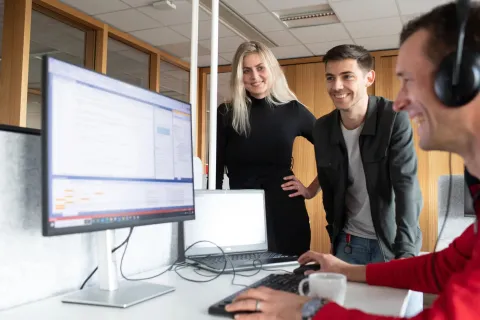
"The goal of the project was to shift from 'gut feeling' to data-driven forecasting."
Joram Span studied mathematics and then worked for three years at a manufacturing company as a supply chain analyst. In this blog, he shares his first project at ilionx.
As a supply chain analyst, I became familiar with working smartly with data. Data science, machine learning, and AI are developing rapidly, and at ilionx I can grow in those areas too. My first assignment was with an American manufacturer of bicycles and bicycle parts, Specialized. They make mountain bikes, racing bikes, clothing, and all kinds of other products, all aimed at sporty cyclists. I had never heard of them before, and I’m not a cycling enthusiast either, but it was a great project from which I learned a lot.
What was your role there?
The production time for bicycles is six months, and they wanted to use data to predict how many bikes they needed to order now if they wanted to sell them in six months. Not just in the Netherlands, but across a large part of Europe. Forecasting was largely done manually. The market leaders in 10 countries sent Excel overviews with expected numbers to the demand planner at the headquarters in Arnhem each month: how many bikes, of which type? After some questions or clarifications and a stock check, a total figure was determined for how many bikes needed to be ordered for all of Europe. The goal of the project was to shift from ‘gut feeling’ to data-driven forecasting.
How do you approach something like that?
I followed our standard approach, which starts with a kickoff. In an interactive session, we sat down with the client's stakeholders to understand and clearly define the business question. Then we conducted a data scan: what data is already available that could help solve the problem? How can we make it accessible and with which tools? Next came the analysis phase, where we looked for patterns and events, tested in an ongoing dialogue. Such a dialogue is not only fun but also leads to a better understanding of the business. In the feature engineering phase, we brought all the findings together and tested various models to ultimately arrive at one model that generates the forecast. In this case, the ARIMA model was chosen.
What was the result?
They now have an automated forecast. That doesn't mean they stopped using the Excel overviews — those are still being created. The market leaders in the different countries know the specific local conditions, including factors that are not always easy to capture in a model. The dashboard includes both forecasts: from the model and from the local market leaders. This way, the forecast also works as a benchmark, helping them ask better questions. The entire chain, from purchasing to marketing, has become more manageable, while still accounting for local or unexpected circumstances. Think, for example, of the initially strong increase and then rapid decline in demand due to the COVID-19 pandemic.
What did you personally learn from this project?
A lot! About how to approach a project like this, about new technology, and especially about the role of consultancy. You need to keep asking questions until you uncover the real issue. That can be difficult, because we don’t always have the knowledge, and people within the company sometimes don’t know exactly what they know either. Maybe you’d have to do their job for a while yourself. One important takeaway for me was how crucial adoption is. You always need to listen to users. For instance, I built my models in Power BI, while the people at Specialized worked with Tableau. They couldn't really use Power BI effectively, so I adapted it.
How did ilionx support you during this project?
It was my first assignment and quite nerve-wracking because I wasn’t sure if I could do it. Luckily, I didn’t have to do it alone. I worked closely with a colleague from sales. That meant I didn’t have to worry about managing the client relationship. And when I got stuck, he connected me with an experienced colleague from another office. I also worked with a lead consultant who was closely involved in the project, and I could always turn to him for sparring. My manager really encouraged me and gave me a lot of trust and autonomy. If I needed help, we looked together at who in the organization could support us. Entrepreneurship is truly valued here — that’s quite unique.

